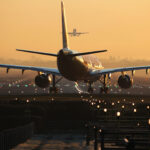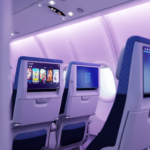The April 8 eclipse is the last total eclipse that will be seen over North America until 2044 – and airlines have been laying on special flights for those who want to view it.
FINN spoke to Dr. Frederic Bertley, president and CEO of COSI, a leading science museum in Columbus, Ohio, about the event and what airline passengers will experience during the eclipse.
Why is viewing the Eclipse from a plane such an epic event?
Dr. Frederic Bertley: Total solar eclipses witnessed at any given location on our dear planet are extremely rare. So when the opportunity arises, you do not want to miss it. Enter unpredictable weather. Imagine, it is finally here. The opportunity to see your first, and perhaps only, total solar eclipse in your lifetime. You are readied with protective glasses, your picnic cooler of snacks and beverages, some soft, some adult, are all by your side as you prepare your lawn chair. In short it is akin to your classic sporting event replete with all of your tailgating gear. The eclipse is coming. And you are getting ready to witness your 2 – 4 minutes of awe and wondrous splendor.
Unfortunately, with all of your giddy and months anticipation and preparation, the Gods have conspired against you and it is cloudy. Yes, it is overcast, cloudy, generally just terrible weather.
Well, whether that was a bad dream, or it really happened to you, there is an elegant solution to assuring you get the best solar eclipse viewing possible. Outsmart that Greek weather God, Zeus, and take it up a notch. Literally. Climb the heavens and catch a flight. That’s right, head up in the skies, and you will be “guaranteed” to enjoy an amazing solar eclipse experience.
Indeed, there are but a few ways to make certain you experience a “rare” solar eclipse. Take a commercial, charter or private flight along the path of totality!
What makes viewing the eclipse from a plane particularly special?
Much of the path of totality in the U.S. has a 60%-80% chance of cloud cover on the ground, with Texas being the most likely location for clear skies. Cloud cover, depending on how dense, can minimise or completely occlude the eclipse to a viewer on the ground. But if you are on a plane, you have the opportunity to rise above the clouds and interfering weather patterns, thereby minimising or eliminating atmospheric blurring or distortion.
The perspective is also different viewing the eclipse from the ground versus 30,000 feet in the air. Similar to witnessing a sunrise or sunset from the window of your flight, your angle to the horizon provides a slightly different aspect ratio.
Another really exciting advantage exists if you are on a flight that is actually traveling the path of totality. On the ground, you are static, while on a flight you are, of course, moving. The typical commercial flight travels at approximately 500 mph. The shadow on the path of totality is also moving, roughly at a speed of 1000 mph. Traveling eastward at that speed on the airplane has the observing effect of “slowing down” the speed at which the shadowy path travels by 50%, taking your viewing pleasure from four-minutes plus on the ground to six-minutes plus in the air. Should you be traveling in the opposite direction of the path of totality, you will have a little more than two-minutes to enjoy the eclipse.
Regardless of where you are on the plane and which direction you are travelling, the sky will appear like night time when you are in the path of totality. The difference will be if you get to see the eclipse’s corona or not.
What are the specific elements to consider for airlines when planning viewing flights?
Key elements to consider include direction of the flight. In this case, you want to be traveling from west to east, mimicking the trajectory of path of totality. In addition, you want to be on the right side of the plane traveling eastwardly. If you happen to be traveling against the direction of the shadow, then you want to be on the left side of the plane. Either way, on a smaller aircraft you might still be able to look across the aisle through the opposite window, but on much larger vessels, this would most likely not be possible.
Due to weight and balance requirements, pilots will not support half of the passengers joining the other half and crowding over towards one side of the plane. Commercial flights will be strict on your movements throughout the cabin, but charter and private flights may allow for more flexibility.
Finally, whether viewing the eclipse from the ground or up in the air, wearing protective eyewear is critical. At this time, you are now welcome to move about the cabin – just be sure to have your eclipse glasses on. Bon voyage!
Subscribe to the FINN weekly newsletter
You may also be interested in
AEROCOR sees increase in Eclipse pilot training
Delta extends reach as world’s most valuable airline brand
Emirates achieves autism centre designation for Dubai check-in

